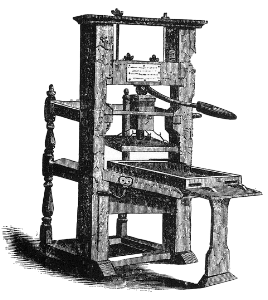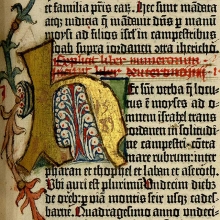 
 Johannes Gutenberg, born in Mainz, Germany was a German goldsmith, craftsman and inventor who originated a method of printing from movable type some time around the year 1448. Before the invention of the printing press, books were written and copied by hand. Block printing was becoming more popular, which involved carving each page of a text into a block of wood and pressing it onto paper. Because these processes were so labour-intensive, books were very expensive, and only the rich could afford them.
Johannes Gutenberg, born in Mainz, Germany was a German goldsmith, craftsman and inventor who originated a method of printing from movable type some time around the year 1448. Before the invention of the printing press, books were written and copied by hand. Block printing was becoming more popular, which involved carving each page of a text into a block of wood and pressing it onto paper. Because these processes were so labour-intensive, books were very expensive, and only the rich could afford them.Gutenberg started working on a device that would make it possible to print texts using movable blocks of letters and images. These blocks, used with paper, ink, and a press, would make it possible to print books much faster and more cheaply than ever before. He used metals that he was familiar with, including lead and tin, to cast 290 blocks of letters and symbols, and he created a linseed-soot-based ink of a consistency ideal for printing on handmade paper. He adapted a wine press that allowed him to slide paper in and out of it and to squeeze water from the paper after printing. Gutenberg's printing press was considered a history-changing invention, making books widely accessible and ushering in an 'information revolution'. He may have operated a printing shop through the 1450s and maybe into the 1460s.  Gutenberg's masterpiece was the Forty-two-Line Bible, completed by 1455, which may have earned him a great deal of money. ('Forty-two Line' refers to the number of lines per page).
Gutenberg's masterpiece was the Forty-two-Line Bible, completed by 1455, which may have earned him a great deal of money. ('Forty-two Line' refers to the number of lines per page). Referred to as the Gutenberg Bible and printed in Latin, it was the first complete book and one of the earliest printed from movable type. As many as six people worked on setting type and looking after the printing process. More than 150 large-format copies were produced. While books would continue to be written by hand in the centuries that followed, this printing process became increasingly more important, helping change how information traveled across Europe, and later the world. The first printed book in Europe to bear the name of its printer was a magnificent Psalter (book of the Psalms) completed in 1457. It was decorated with hundreds of two-colour initial letters and delicate scroll borders that were printed by multiple inking on a single metal block. Such illuminations of the text had been traditionally done by hand with paint. |